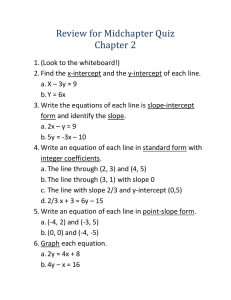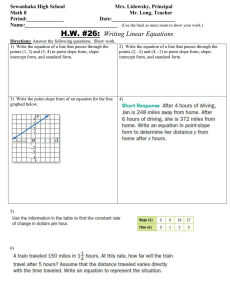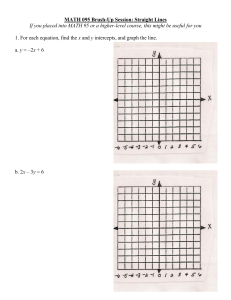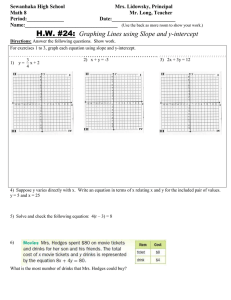A set is a collection of objects. A well
advertisement
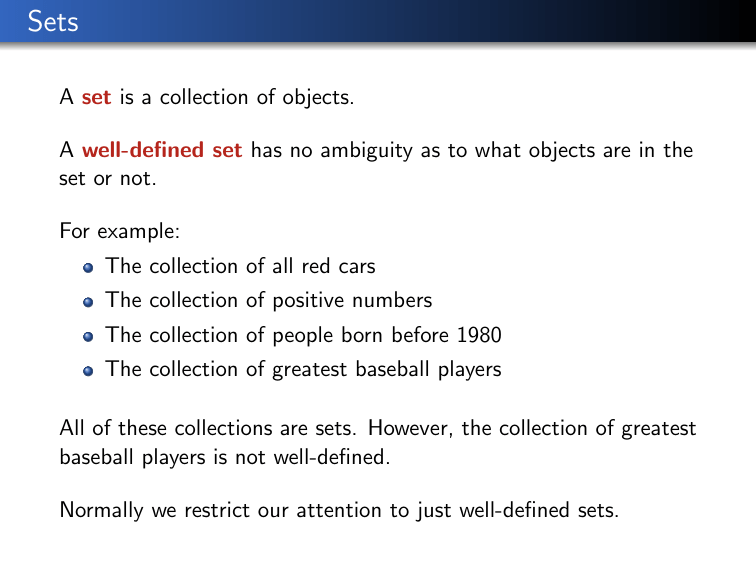
Sets A set is a collection of objects. A well-defined set has no ambiguity as to what objects are in the set or not. For example: The collection of all red cars The collection of positive numbers The collection of people born before 1980 The collection of greatest baseball players All of these collections are sets. However, the collection of greatest baseball players is not well-defined. Normally we restrict our attention to just well-defined sets. Functions A function consists of 3 things: 1. A set called the domain 2. A set called the range 3. A rule that gives a relationship between the domain and range We write f : A → B to mean that the function f has domain A and range B. A function can be thought of as taking something from the domain and returning something in the range. In 2120 our functions will normally “map” numbers to numbers (i.e. the domain and range of our functions are sets of numbers). Thus, we often will not explicitly define the domain and range of our function. However, there are other types of functions. For example, the function that maps final averages to letter grades. Functions A function has a rule that gives a relationship between the domain and range. Given an item from the domain this rule must return exactly one value from the range. This rule is often given as an equation. For example, f (x) = 2x + 1. This rule says to map an object to two times itself plus 1. f (0) f (1) f (5) f (3.5) f (y) f (z + 2) = = = = = = Functions A function has a rule that gives a relationship between the domain and range. Given an item from the domain this rule must return exactly one value from the range. This rule is often given as an equation. For example, f (x) = 2x + 1. This rule says to map an object to two times itself plus 1. f (0) f (1) f (5) f (3.5) f (y) f (z + 2) = = = = = = 2·0+1=1 Functions A function has a rule that gives a relationship between the domain and range. Given an item from the domain this rule must return exactly one value from the range. This rule is often given as an equation. For example, f (x) = 2x + 1. This rule says to map an object to two times itself plus 1. f (0) f (1) f (5) f (3.5) f (y) f (z + 2) = = = = = = 2·0+1=1 2·1+1=3 Functions A function has a rule that gives a relationship between the domain and range. Given an item from the domain this rule must return exactly one value from the range. This rule is often given as an equation. For example, f (x) = 2x + 1. This rule says to map an object to two times itself plus 1. f (0) f (1) f (5) f (3.5) f (y) f (z + 2) = = = = = = 2·0+1=1 2·1+1=3 2 · 5 + 1 = 11 Functions A function has a rule that gives a relationship between the domain and range. Given an item from the domain this rule must return exactly one value from the range. This rule is often given as an equation. For example, f (x) = 2x + 1. This rule says to map an object to two times itself plus 1. f (0) f (1) f (5) f (3.5) f (y) f (z + 2) = = = = = = 2·0+1=1 2·1+1=3 2 · 5 + 1 = 11 2 · 3.5 + 1 = 8 Functions A function has a rule that gives a relationship between the domain and range. Given an item from the domain this rule must return exactly one value from the range. This rule is often given as an equation. For example, f (x) = 2x + 1. This rule says to map an object to two times itself plus 1. f (0) f (1) f (5) f (3.5) f (y) f (z + 2) = = = = = = 2·0+1=1 2·1+1=3 2 · 5 + 1 = 11 2 · 3.5 + 1 = 8 2y + 1 Functions A function has a rule that gives a relationship between the domain and range. Given an item from the domain this rule must return exactly one value from the range. This rule is often given as an equation. For example, f (x) = 2x + 1. This rule says to map an object to two times itself plus 1. f (0) f (1) f (5) f (3.5) f (y) f (z + 2) = = = = = = 2·0+1=1 2·1+1=3 2 · 5 + 1 = 11 2 · 3.5 + 1 = 8 2y + 1 2(z + 2) + 1 = 2z + 5 Graphs We often think of a graph as a “picture” of a function. The graph of a function f is the set of all points (x, y) that satisfy the equation y = f (x) Consider the function f (x) = x2 + 1. The graph of f is all of the points that satisfy y = x2 + 1. x y 0 1 1 2 -1 2 2 5 -2 5 3 10 -3 10 Graphs We often think of a graph as a “picture” of a function. The graph of a function f is the set of all points (x, y) that satisfy the equation y = f (x) Consider the function f (x) = x2 + 1. The graph of f is all of the points that satisfy y = x2 + 1. x y 0 1 1 2 -1 2 2 5 -2 5 3 10 -3 10 Graphs We often think of a graph as a “picture” of a function. The graph of a function f is the set of all points (x, y) that satisfy the equation y = f (x) Consider the function f (x) = x2 + 1. The graph of f is all of the points that satisfy y = x2 + 1. x y 0 1 1 2 -1 2 2 5 -2 5 3 10 In this case we “know” the graph is a parabola so only a few points are needed. -3 10 Lines Any function that can be put into the following form is called a linear function. f (x) = mx + b This form is called Slope-Intercept Form: m is the slope of the line and tells how steep the line is b is the y-component of the y-intercept (0, b). The point (0, b) always satisfies y = mx + b and is where the line “hits” the y-axis. Graphing lines takes just two points. Lines Consider the linear function f (x) = −2x + 1. The slope is The y-intercept is Graph f (x) = −2x + 1 Lines Consider the linear function f (x) = −2x + 1. The slope is −2 The y-intercept is Graph f (x) = −2x + 1 Lines Consider the linear function f (x) = −2x + 1. The slope is −2 The y-intercept is (0, 1) Graph f (x) = −2x + 1 Lines Consider the linear function f (x) = −2x + 1. The slope is −2 The y-intercept is (0, 1) Graph f (x) = −2x + 1 Slope Slope Formula: Suppose you know two distinct points on a line, (x1 , y1 ) and (x2 , y2 ). If x1 6= x2 then m= change in y “rise” y2 − y1 = = . x2 − x1 change in x “run” If x1 = x2 , then m is undefined and the line is vertical. What is the slope of the line through the points (1, 2) and (3, 6)? Slope Slope Formula: Suppose you know two distinct points on a line, (x1 , y1 ) and (x2 , y2 ). If x1 6= x2 then m= change in y “rise” y2 − y1 = = . x2 − x1 change in x “run” If x1 = x2 , then m is undefined and the line is vertical. What is the slope of the line through the points (1, 2) and (3, 6)? m= 6−2 4 = =2 3−1 2 Slope When you know the slope of a line and a point on the line it is easy to find more points on the line. Just move “over” by the run and “up” by the rise. f (x) = −2x + 1, m = − 21 , y-intercept = (0, 1) Slope When you know the slope of a line and a point on the line it is easy to find more points on the line. Just move “over” by the run and “up” by the rise. f (x) = −2x + 1, m = − 21 , y-intercept = (0, 1) Slope When you know the slope of a line and a point on the line it is easy to find more points on the line. Just move “over” by the run and “up” by the rise. f (x) = −2x + 1, m = − 21 , y-intercept = (0, 1) Slope When you know the slope of a line and a point on the line it is easy to find more points on the line. Just move “over” by the run and “up” by the rise. f (x) = −2x + 1, m = − 21 , y-intercept = (0, 1) Slope When you know the slope of a line and a point on the line it is easy to find more points on the line. Just move “over” by the run and “up” by the rise. f (x) = −2x + 1, m = − 21 , y-intercept = (0, 1) Slope Slope also gives us a general feel for how the line looks even without graphing it. Positive slope Negative slope Zero slope Undefined slope Point-Slope Form While slope-intercept form requires both the slope and the y-intercept if we know the slope and any point on the line we can find an equation for the line. Point-Slope Form: Given a point (x1 , y1 ) on a line and its slope m an equation for the line is: y − y1 = m(x − x1 ) How can we turn point-slope form into slope-intercept form? Point-Slope Form While slope-intercept form requires both the slope and the y-intercept if we know the slope and any point on the line we can find an equation for the line. Point-Slope Form: Given a point (x1 , y1 ) on a line and its slope m an equation for the line is: y − y1 = m(x − x1 ) How can we turn point-slope form into slope-intercept form? We can transform point-slope form into slope-intercept form by solving for y. y = mx − mx1 + y1 , b = y1 − mx1 Point-Slope Form Give an equation in point-slope form for the line with slope m = 2 that passes through the point (1, 2). What is the y-intercept? Point-Slope Form Give an equation in point-slope form for the line with slope m = 2 that passes through the point (1, 2). y − 2 = 2(x − 1) What is the y-intercept? Point-Slope Form Give an equation in point-slope form for the line with slope m = 2 that passes through the point (1, 2). y − 2 = 2(x − 1) What is the y-intercept? y = 2x − 2 + 2 = 2x So b = 0 and the y-intercept is (0, 0). Two Point Form Suppose we are given two distinct points on a line. How can we find an equation for the line? Two Point Form Suppose we are given two distinct points on a line. How can we find an equation for the line? Find the slope and use one of the points to write a point-slope form equation. y − y1 = y2 − y1 (x − x1 ) x2 − x1 Parallel and Perpendicular Lines Parallel lines are either equal (the same line) or never touch. In either case they have the same slope (or both slopes are undefined). Perpendicular lines meet at 90◦ . If two lines are perpendicular and m1 is the slope of one line and m2 is the slope of the other, then: m1 m2 = −1, m2 = − m11 , m1 = 0, m2 = ∞, or m1 = ∞, m2 = 0. Cost Function Linear functions are important because they are simple but expressive. Many real world processes can be modeled with linear functions. Cost function: C(x) = ax + b where x is the number of items b is the fixed cost (in dollars) a is the unit cost (in dollars) C(x) is the total cost to make x items (in dollars) Costs The fixed cost is the amount a manufacturer has to pay regardless of how many items are produced (e.g. rent, utilities, setup,...) The unit cost is the amount a manufacturer has to pay per item (e.g. supplies, ingredients,...) Cost Function Example Suppose a band wants to make some CDs of their work to sell. The CD burner cost $50 and each blank CD cost $0.25. What is their cost function? How much would it cost to make 200 CDs? How many CDs can they make with $75? Cost Function Example Suppose a band wants to make some CDs of their work to sell. The CD burner cost $50 and each blank CD cost $0.25. What is their cost function? C(x) = 0.25x + 50 How much would it cost to make 200 CDs? How many CDs can they make with $75? Cost Function Example Suppose a band wants to make some CDs of their work to sell. The CD burner cost $50 and each blank CD cost $0.25. What is their cost function? C(x) = 0.25x + 50 How much would it cost to make 200 CDs? C(200) = 0.25 · 200 + 50 = 50 + 50 = 100 How many CDs can they make with $75? Cost Function Example Suppose a band wants to make some CDs of their work to sell. The CD burner cost $50 and each blank CD cost $0.25. What is their cost function? C(x) = 0.25x + 50 How much would it cost to make 200 CDs? C(200) = 0.25 · 200 + 50 = 50 + 50 = 100 How many CDs can they make with $75? C(x) = 75 0.25x + 50 = 75 0.25x = 25 x = 100 Unknown Costs Many times a business can not separate their fixed costs and unit costs. However, they can be determined if they know their total costs for producing two different amounts of product. Suppose a shop-owner knows they can make 10 suits in a week for $360 and 7 suits in a week for $270. How can we find the cost function? What are the two points? Unknown Costs Many times a business can not separate their fixed costs and unit costs. However, they can be determined if they know their total costs for producing two different amounts of product. Suppose a shop-owner knows they can make 10 suits in a week for $360 and 7 suits in a week for $270. How can we find the cost function? Determine the cost function by finding the slope. What are the two points? Unknown Costs Many times a business can not separate their fixed costs and unit costs. However, they can be determined if they know their total costs for producing two different amounts of product. Suppose a shop-owner knows they can make 10 suits in a week for $360 and 7 suits in a week for $270. How can we find the cost function? Determine the cost function by finding the slope. What are the two points? (10, 360), (7, 270) So the slope is m = 360−270 10−7 = 90 3 = 30. Unknown Costs Now that we know the slope and a point we can find the a point-slope form equation for the line. y − 360 = 30(x − 10) We then solve for y to find the cost function. y = 30(x − 10) + 360 = 30x − 300 + 360 = 30x + 60 C(x) = 30x + 60 Their fixed cost is Their unit cost is . . Unknown Costs Now that we know the slope and a point we can find the a point-slope form equation for the line. y − 360 = 30(x − 10) We then solve for y to find the cost function. y = 30(x − 10) + 360 = 30x − 300 + 360 = 30x + 60 C(x) = 30x + 60 Their fixed cost is $60. Their unit cost is . Unknown Costs Now that we know the slope and a point we can find the a point-slope form equation for the line. y − 360 = 30(x − 10) We then solve for y to find the cost function. y = 30(x − 10) + 360 = 30x − 300 + 360 = 30x + 60 C(x) = 30x + 60 Their fixed cost is $60. Their unit cost is $30. Revenue Function Revenue function: R(x) = sx where x is the number of items sold s is the sell price of the item R(x) is the total revenue from selling x items Supposed the shop owner sell their suits for $50 each. R(x) = 50x Break-Even Point The break-even point is the point where total cost equals total revenue. R(x) = C(x) What is the break-even point for our suit selling shop owner (remember the break-even point is a point)? C(x) = 30x + 60 R(x) = 50x Break-Even Point The break-even point is the point where total cost equals total revenue. R(x) = C(x) What is the break-even point for our suit selling shop owner (remember the break-even point is a point)? C(x) = 30x + 60 R(x) = 50x 50x = 30x + 60 20x = 60 x=3 Break-Even Point The break-even point is the point where total cost equals total revenue. R(x) = C(x) What is the break-even point for our suit selling shop owner (remember the break-even point is a point)? C(x) = 30x + 60 R(x) = 50x 50x = 30x + 60 20x = 60 x=3 Now that we know x we need to solve for y. y = 50 · 3 = 150 The break even point is: (3, 150) Break-Even Point We can solve for the break-even point algebraically. R(x) = C(x) sx = ax + b (s − a)x = b b x = s−a Thus, sb b s−a , s−a is the general break-even point. For our suit selling shopowner, a = 30, b = 60, and s = 50. So 50·60 60 the break-even point is 50−30 , 50−30 = (3, 150). However, it is “better” to remember the process of setting total cost equal to total revenue than to memorize the break-even point formula. Break-Even Point Geometrically the break-even point occurs where the graphs of C(x) and R(x) intersect.

